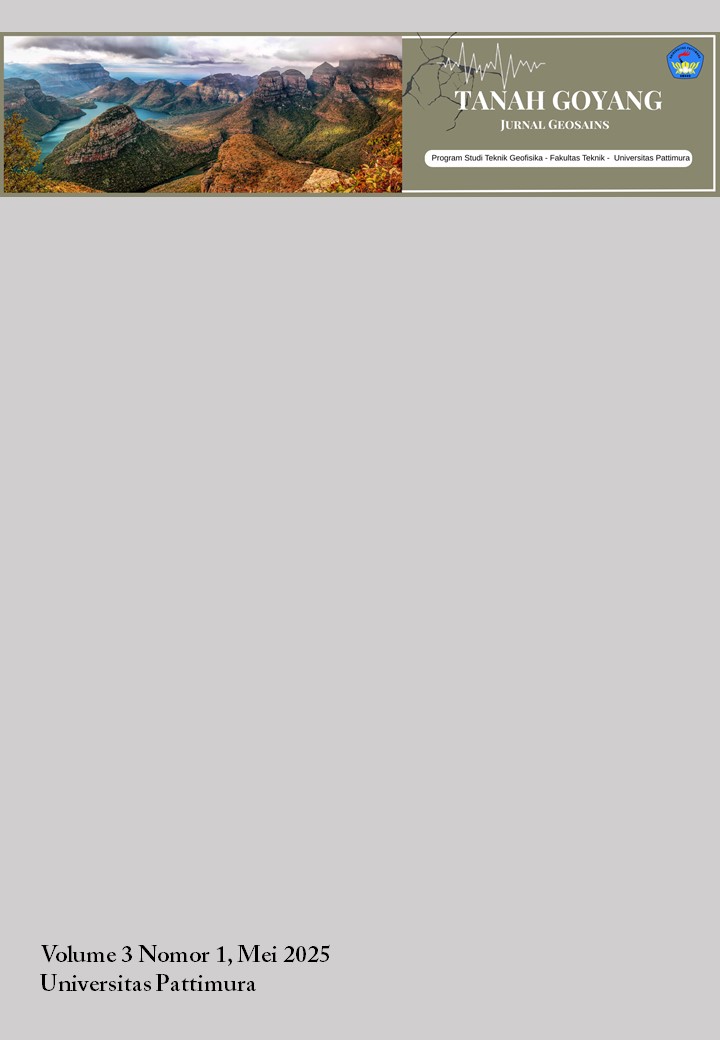Identifikasi Air Tanah Menggunakan Electrical Resistivity Tomography di Lingkungan Sekolah Rakyat Menengan Atas 40 Ambon
Abstract
Clean water availability is a vital requirement for supporting learning activities and maintaining health within educational environments. Sekolah Rakyat Ambon, located in Maluku, still experiences limited access to clean water due to complex local geological conditions and the absence of a well-identified groundwater system. This study aims to identify potential aquifer zones around Sekolah Rakyat Ambon using the 2D Electrical Resistivity Tomography (ERT) method as a basis for groundwater drilling site selection. The survey was conducted along a 156-meter line with a 4-meter electrode spacing using the Wenner-Schlumberger configuration. The inversion results reveal a low-resistivity zone (10–50 Ωm) at a depth of approximately 25–30 meters, interpreted as a saturated aquifer layer. Based on this interpretation, drilling was carried to a depth of 30 meters. Borehole observations confirmed the presence of water-bearing sandy layers consistent with the ERT results. Physical water quality testing yielded values of pH 8.20, EC 273 µS/cm, TDS 146 ppm, salinity 0.001%, and specific gravity 1 g/cm³, indicating that the water is suitable for clean water use. The discharge measurement resulted in a flow rate of approximately 25 liters per minute, sufficient to meet the school’s daily water needs.
Downloads
References
Arjwech, R. and Everett, M. E. (2024). Sinkhole formation induced by descending groundwater in a karst aquifer near a limestone quarry. Earth Surface Processes and Landforms, 49(15), 5027-5037. https://doi.org/10.1002/esp.6010
Bahri, S., Ramadhan, A., & Zulfiah. (2023). Investigation of groundwater quality using vertical electrical sounding and Dar Zarrouk parameter in Leihitu, Maluku, Indonesia. Journal of Geoscience Engineering, Environment and Technology, 8(3), 12976. https://doi.org/10.25299/jgeet.2023.8.3.12976
Bahri, S., Ramadhan, A., & Patty, P. J. (2025). Adaptive Flower Pollination Algorithm (FPA) for Vertical Electrical Sounding (VES) Inversion Modelling. Pure Appl. Geophys, https://doi.org/10.1007/s00024-025-03799-8
Hall, R. 2011. Australia–SE Asiacollision: plate tectonics andcrustal flow. In: Hall, R., CottamM. A., & Wilson M. E. J. (eds). The SE Asian Gateway: Historyand Tectonics of the Australia–Asia Collision. Geological Society, London, Special Publication, 355, 75–109. DOI:10.1144/SP355.5
Hung, Y. C., Chou, H. S., & Lin, C. (2020). Appraisal of the spatial resolution of 2d electrical resistivity tomography for geotechnical investigation. Applied Sciences, 10(12), 4394. https://doi.org/10.3390/app10124394
Jaya, G. W., Bahri, S., Ramadhan, A., Nggolaon, D., & Silahoy, S. (2024). Upaya Penyedian Air Tanah Bagi Kelompok Tani Menggunakan Metode Geolistrik Dan Pembuatan Sumur Bor Di Desa Haruru, Maluku Tengah. LOSARI: Jurnal Pengabdian Kepada Masyarakat, 6(2), 266-275. https://doi.org/10.53860/losari.v6i2.408
Linthout, K., & Helmers, H. 1994, Pliocene obducted, rotated and migrated ultramafic rocks and obduction-induced anatectic granite, SW Seram and Ambon, Eastern Indonesia. Journal of Southeast Asian Earth Sciences, 9, 95-109. https://doi.org/10.1016/0743-9547(94)90068-X
Milsom, J. (2003). Geological remote sensing: A practical guide. Blackwell Publishing.
Odoh, B. I., Ezealaji, I. P., & Chukwuneke, C. J. (2024). Integrating geophysical and hydrological data for improved groundwater exploration and monitoring. African Journal of Environment and Natural Science Research, 7(4), 45-51. https://doi.org/10.52589/ajensr-unwueqex
Paepen, M., Hanssens, D., Smedt, P. D., Walraevens, K., & Hermans, T. (2020). Combining resistivity and frequency domain electromagnetic methods to investigate submarine groundwater discharge in the littoral zone. Hydrology and Earth System Sciences, 24(7), 3539-3555. https://doi.org/10.5194/hess-24-3539-2020
Ripamole, J. N. A., Warsa., & Bahri, S. (2025). Identification of Nickel Laterite Deposit in Hukurila Ambon Based on Electrical Resistivity Tomography Data. IOP Conference Series: Earth and Environmental Science. 1458 (012010). https://doi.org/10.1088/1755-1315/1458/1/012010
Shao, P., Shang, Y., Hasan, M., Yi, X., & He, M. (2021). Integration of ert, ip and sp methods in hard rock engineering. Applied Sciences, 11(22), 10752. https://doi.org/10.3390/app112210752
Telford, W. M., Geldart, L. P., & Sheriff, R. E. (2004). Applied Geophysics. Cambridge University Press.
Tjokrosapoetro, S., Rusmana, E., & Achdan, A. (1993). Peta Geologi Lembar Ambon.
Watkinson, I., Hall, R., & Ferdian, F. (2011). Tectonic re-interpretation of the Banggai-Sula–Molucca Sea margin, Indonesia. In R. Hall, M. Cottam, & M. Wilson (Eds.), The SE Asian gateway: history and tectonics of Australia-Asia collision (Vol. 355, pp. 203-224). Geological Society of London Special Publication. https://doi.org/10.1144/SP355.10
Copyright (c) 2025 Husnaniah Kaharudin

This work is licensed under a Creative Commons Attribution 4.0 International License.








1.png)

